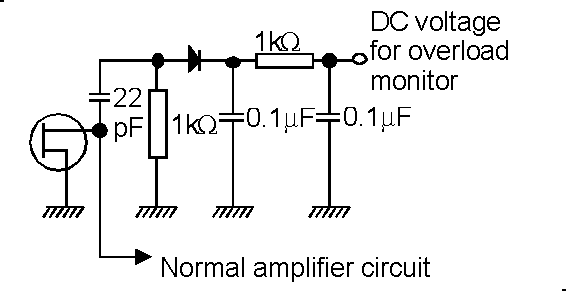Many amplifiers can saturate.
There are many amplifiers in a receiver that can saturate and cause degraded performance.All amplifiers followed by a filter that does not allow the next amplifier to get all signals at full amplitude are possible sources of problems. Saturation may occur without enough signal entering the next stage to cause saturation further down the signal path.
Saturation is often undetected. It just degrades the receiver performance by an increased noise floor or by the presence of spurious signals.
A simple RF voltmeter for overload monitoring
Fig. 1 shows one way of finding out what RF voltage is present at the amplifier output. In case the amplifier is a GAS-FET it is a good idea to use microwave components because then self oscillations that may occur in the microwave region will also be detected.

Fig. 1. Using a schottky diode like 1N6263 to sense the RF voltage at the drain/collector of an amplifier transistor.
In case the DC monitor voltage is loaded by a low impedance some intermodulation may be created in the schottky diode. This is a very small effect, difficult to detec.
The overload detector shows about 1V at the 3dB saturation point for a MGF1801 amplifier that is tuned for minimum noise figure with 2.6V at the drain (0.8V at the source). This amplifier has a tuning capacitor of about 2pF and has 3dB compression at -7dBm on 144MHz and +6dBm at 90MHz. Table 1 shows a two tone test for this amplifier which is not designed for good IM3. It is neutralised and the gain is 27dB.
If the DC output from the schottky diode is shorted the third order intermodulation is increased by 3dB at an input signal of -45dBm. At lower input levels the diode current is too small for a measurable effect and at larger input voltages the IM3 from the transistor dominates so the effect of shorting the DC output can not be seen.
An RF voltmeter at the output of the second RF amplifier will allow
a check that the filtering before it is adequate.
Adding an RF voltmeter at the drain of preamplifiers is
a very good idea.
The possibillity to make sure no amplifier is overloaded
is very valuable.
Since neither the preamplifier nor the antenna is matched to
the transmission line it may be possible to avoid overload by out of band
signals simply by changing the total cable length between the antenna
and the preamplifier.
The DC voltage can be used to check if the insertion of some extra length
of cable makes a significant difference.
Input Output IM3 Monitor DC
(dBM) (dBm) (dBm) (V)
-50 -23.2 -95 0.003
-40 -12.8 -87 0.025
-30 -3.2 -56 0.160
-25 +1.2 -37.2 0.334
-20 +5.6 -22.0 0.636
-15 +9.6 -11.2 1.030
-10 +12.0 -4.0 1.367
Table 1 Two tone test at 144MHz on a neutralised
MGF1801 amplifier tuned for minimum noise figure.
The table gives the level for one of two equally strong
signals separated by about 100kHz.
The peak power handeled by the amplifier is 6dB larger.
Third order input intercept point is about 0dBm.